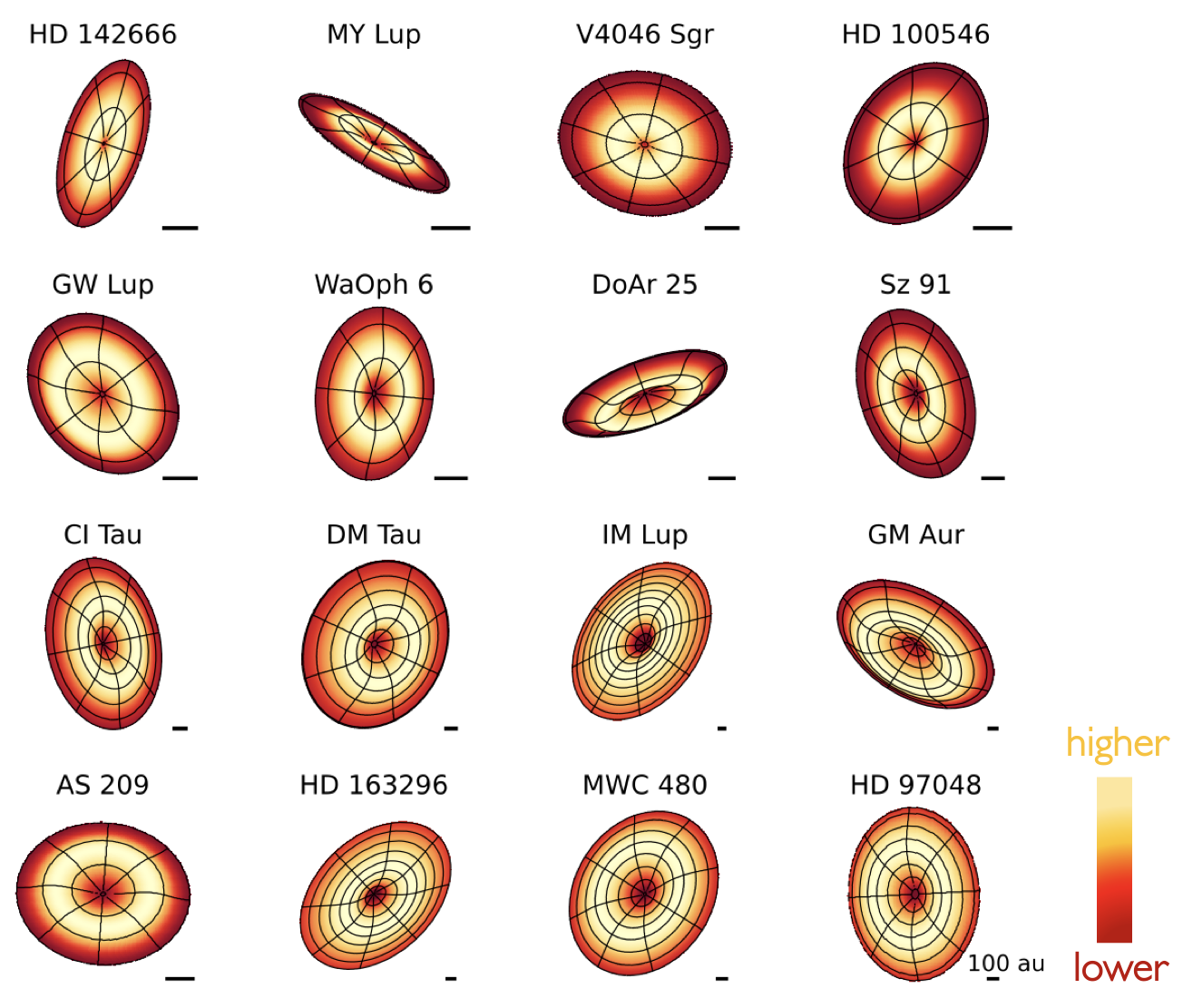Research
Chemical signatures of embedded planets

Chemical signatures of a planet in the HD 169142 disk. (Law+23b)
The ubiquity of rings and gaps detected in the mm dust around planet-forming disks suggests the presence of embedded young planets. However, it is difficult to unambiguously connect individual substructures with the location and properties of nascent planets, while the direct detection of these planets remains elusive. One promising alternative to planet detection and characterization is the use of chemical tracers. Embedded planets alter the chemistry by locally heating the disk and sublimating volatile-rich ices, or in extreme cases, causing shocks. Observations of molecular gas with ALMA are now beginning to reveal such chemical signatures.
Vertical gas and thermal structure in planet-forming disks

3D representations of 12CO emitting surfaces in a large sample of protoplanetary disks (Law+21c , Law+22 , Law+23a, Law+24)
Molecular line emission in protoplanetary disks originates from elevated surface layers above the midplane. The vertical distribution of this molecular material depends on gradients in physical conditions, such as temperature, density, and radiation, and is also influenced by a variety of disk processes, e.g., turbulent mixing or meridional flows driven by embedded planets. However, we require detailed knowledge of where line emission emanates to interpret a variety of observations, incluing kinematic signals in CO emission, rotation map-based dynamical stellar and disk mass estimates, and the chemistry of planet formation.
Chemical substructures in protoplanetary disks

Radial substructures from the MAPS LP (Law+21b)
Protoplanetary disks provide the raw materials for forming planets. Disk observations can provide crucial constraints on the formation locations of planets and the processes by which initial gas and dust distributions evolve into planetary systems. Disks are highly structured in both their radial and vertical gas distributions and high spatial resolution observations are necessary to not only identify and catalogue the frequency of such substructures but also to relate them to the distribution of dust as well as their influence of nascent planets. Such observations are also required to reveal the inner planet forming zones of these disks (<50 au) in order to uncover the chemical environments in which planets are assembled.
Spatially-resolved chemistry in massive young stellar objects

Complex organic molecules in massive star-forming region G10.6 (Law+21a)
The elevated temperatures and densities generated from collapsing material results in a high degree of chemical complexity toward massive young stellar objects (MYSOs). However, the complex chemical and physical processes driving these regions are not fully understood, despite decades of observational and modeling efforts, which is in part due to limitations in observations of complex chemisty at sufficiently high spatial resolutions. Such observations, which directly resolve the spatial differences between the emission of distinct species allow us to unambiguously discern the regions traced by different molecular species and families of molecules, providing further insight into their formation processes and chemistry. As a result, they are crucial for constraining a variety of outstanding questions related to the chemical evolution of MYSOs, including but ceratinly not limited to: How frequently and in what way are hot cores associated with MYSOs? What processes and evolutionary stages are responsible for COM production in massive star-forming regions? Are there several distinct COM chemistries that can be used to trace different aspects of star formation? Are O- and N-bearing COMs systematically spatially offset from one another?
Kinematics, morphology, and ISM/CSM environment of SNRs

3D reconstruction of SNR N132D (Law+20)
Young, nearby supernova remnants (SNRs) offer rare opportunities to investigate kinematic and chemical details of supernova (SN) explosions at fine scales that are impossible to achieve in unresolved extragalactic events. Their morphology and elemental distribution provide unique insight into where and how asymmetry is introduced during core collapse, which is presently a key area of investigation in increasingly sophisticated 2D and 3D simulations. Expanding stellar ejecta that encode valuable information about the explosion dynamics, nucleosynthetic yields, and mixing of the progenitor star can be resolved, measured, and tracked. The progenitor star system’s transitions through evolutionary stages leading up to core collapse and associated mass loss can also be explored by studying the SNR’s interaction with its surrounding environment.
